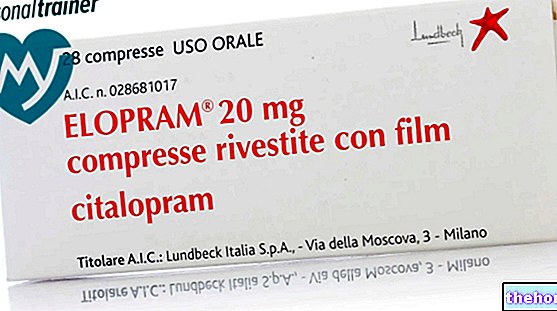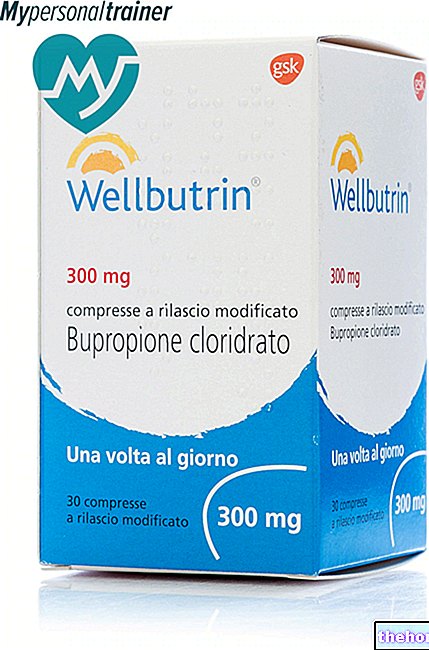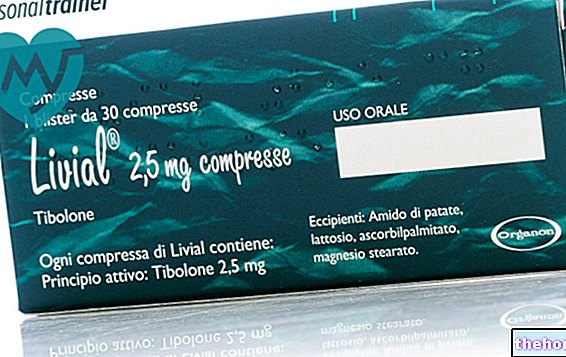Active ingredients: Lacidipine
Lacirex 4 mg film-coated tablets
Lacirex 6 mg film-coated tablets
Indications Why is Lacirex used? What is it for?
Lacirex is used for the treatment of high blood pressure (hypertension). It belongs to a class of medicines called 'calcium channel blockers.' 'Lacirex has the property of widening (dilating) blood vessels, facilitating blood flow and lowering blood pressure.
Contraindications When Lacirex should not be used
Do not take Lacirex:
- if you are allergic (hypersensitive) to the active substance or to any of the other ingredients of Lacirex
- if you have a heart disease called aortic stenosis. This disease is a narrowing of the valve that allows blood to be pumped out of the heart
- if you think any of these apply to you, do not take Lacirex until you have talked to your doctor.
Precautions for use What you need to know before taking Lacirex
Before treatment with Lacirex your doctor should know:
- if you have heart problems
- if you have liver disease
Interactions Which drugs or foods can modify the effect of Lacirex
Tell your doctor or pharmacist if you are taking or have recently taken any other medicines, including medicines obtained without a prescription.
Some medicines can alter the way Lacirex works, or increase it causing side effects. Lacirex can also alter the way some other medicines work. Including:
- other medicines used to treat high blood pressure such as furosemide, propanolol or captopril
- cimetidine (to treat stomach ulcers)
- cyclosporine (used for the prevention of organ transplant rejection or for some autoimmune diseases).
Concomitant use of lacidipine and corticosteroids or tetracosactide may decrease the antihypertensive effect.
- Talk to your doctor or pharmacist if you are taking any of these medicines.
Taking Lacirex with food or drink
Do not drink grapefruit juice while you are taking Lacirex.
Warnings It is important to know that:
Pregnancy and breastfeeding
Ask your doctor or pharmacist for advice before taking any medicine.
There is no information on the safe use of Lacirex in pregnancy. If you are pregnant or think you are pregnant, or if you are planning to become pregnant, do not take Lacirex without first checking with your doctor. Your doctor will consider the risks and benefits of taking Lacirex for you and your baby.
The active substance and ingredients of Lacirex can pass into breast milk. If you are breastfeeding, check with your doctor before starting Lacirex therapy.
Driving and using machines
Lacirex can cause dizziness. Patients should be advised not to drive or operate machinery if subject to dizziness or associated symptoms.
Important information about some of the ingredients of Lacirex
Lacirex contains lactose. If you have been told by your doctor that you have an intolerance to some sugars, contact your doctor before taking this medicinal product.
Dose, Method and Time of Administration How to use Lacirex: Posology
How much to take
Always take Lacirex exactly as your doctor has told you. If in doubt, consult your doctor or pharmacist. Check with your doctor or pharmacist if you are not sure.
The usual starting dose of Lacirex is 2 mg once daily in the morning.
Your doctor may decide whether to increase the dose to 4 or 6 mg once daily in the morning after approximately 3-4 weeks of therapy.
How to take it
Swallow the tablet with some water.
It is preferable to take the medicine at the same time each day.
You can take Lacirex with or without food.
Overdose What to do if you have taken an overdose of Lacirex
If you forget to take Lacirex
If you forget to take a dose, take the next one at the same time. Do not take a double dose to make up for a forgotten tablet.
If you take more Lacirex than you should
If you take too many Lacirex tablets it is very likely a drop in blood pressure and a change in heart rate which may increase or decrease.
- Ask your doctor or pharmacist for advice.
If you stop taking Lacirex
Take Lacirex for the time recommended by your doctor. Do not stop taking Lacirex without your doctor's advice.
If you have any further questions on the use of Lacirex, ask your doctor or pharmacist.
Side Effects What are the side effects of Lacirex
Like all medicines, Lacirex can cause side effects, although not everybody gets them.
Common side effects
They can concern from 1 to 10 people:
- irregular heartbeats (palpitations)
- faster heartbeats (tachycardia)
- swelling caused by fluids
- dizziness
- urinating frequently
- headache
- skin rashes (including redness of the skin and itching)
- hot flashes
- gastric disturbances
- nausea
- tiredness
Common side effects that may show up in blood tests:
- reversible increase in the level of an enzyme called alkaline phosphatase
Uncommon side effects
These can affect from 1 to 100 people:
- worsening of chest pain (worsening of pre-existing angina pectoris)
- pallor
- lowering of blood pressure
- bleeding, sore gums
- syncope
- hypotension
Rare side effects
These can affect from 1 to 1000 people:
- severe allergic reactions with swelling of the face, tongue or throat which may cause difficulty in swallowing or breathing
- itchy rash in the skin
Very rare side effects
These can affect from 1 to 10,000 people
- shaking or trembling of the arms and legs
- depression
If you have any of these side effects
- If any of the side effects gets serious, or if you notice any side effects not listed in this leaflet, please tell your doctor or pharmacist.
Expiry and Retention
Keep Lacirex out of the reach and sight of children.
Do not use Lacirex after the expiry date which is stated on the package.
Store Lacirex at temperatures no higher than 30 ° C.
Store in the original container to protect from light.
Do not take the tablet out of the blister until you have to take it.
Medicines should not be disposed of via wastewater or household waste. Ask your pharmacist how to throw away medicines you no longer use. This will help protect the environment.
What Lacirex contains
The active ingredient is lacidipine. Lacirex tablets are present in different dosages.
Each tablet contains:
4 mg of lacidipine 6 mg of lacidipine
The excipients are:
Lactose, povidone, magnesium stearate, hypromellose, titanium dioxide (E 171), polyethylene glycol (PEG) 400, polysorbate 80
Description of what Lacirex looks like and contents of the pack
Lacirex 4 mg tablets are white, oval shaped with a score line on both sides and debossed with "GS" and "3MS" on the other side. Pack size of 28 tablets.
Lacirex 6 mg tablets are white, oval shaped with "GXCX3" debossed on one side. Packs of 14 and 28 tablets.
Source Package Leaflet: AIFA (Italian Medicines Agency). Content published in January 2016. The information present may not be up-to-date.
To have access to the most up-to-date version, it is advisable to access the AIFA (Italian Medicines Agency) website. Disclaimer and useful information.
01.0 NAME OF THE MEDICINAL PRODUCT
LACIREX TABLETS COATED WITH FILM
02.0 QUALITATIVE AND QUANTITATIVE COMPOSITION
LACIREX 4 mg film-coated tablets
One scored film-coated tablet contains:
Active ingredient: Lacidipine 4.00 mg
LACIREX 6 mg film-coated tablets
One film-coated tablet contains:
Active ingredient: lacidipine 6.00 mg
For the full list of excipients, see section 6.1
03.0 PHARMACEUTICAL FORM
Film-coated tablets
04.0 CLINICAL INFORMATION
04.1 Therapeutic indications
Treatment of arterial hypertension as monotherapy or in combination with three antihypertensive drugs such as beta-blockers, diuretics, ACE inhibitors.
04.2 Posology and method of administration
Adults:
The starting dose is 2 mg (half a 4 mg tablet) once a day.
Treatment should possibly be adapted to the severity of the hypertensive disease according to individual needs and the response of the individual patient.
The dose can be increased to 4 mg and if necessary to 6 mg, after allowing adequate time for the full pharmacological effect to take place. In practice this time should not be less than 3-4 weeks, unless the clinical condition does not require a faster switch to a higher dosage.
LACIREX should be taken at the same time each day, preferably in the morning, either before or after food.
Hepatic insufficiency
No dosage modification is required in patients with mild or moderate hepatic impairment.
Insufficient data are available to make a recommendation for patients with severe hepatic impairment (see section 4.4).
Kidney failure
Since lacidipine is not eliminated by the kidney, the dosage in patients with renal insufficiency does not require any modification.
Children
There are no data on the use of LACIREX in children.
Elderly patients
No dosage modification is required.
The treatment can be continued indefinitely.
04.3 Contraindications
Hypersensitivity to the active substance or to any of the excipients.
As with other dihydropyridines, lacidipine is contraindicated in patients with severe aortic stenosis.
As experimental data on the safety of use during pregnancy and lactation are lacking, the drug is contraindicated in these conditions.
04.4 Special warnings and appropriate precautions for use
In the specialized studies carried out it has been shown that lacidipine does not alter the spontaneous function of the sinoatrial node or prolong the conduction time at the level of the atrioventricular node. However, the theoretical potential of calcium channel blockers to affect the activity of the SA and AV nodes must be considered and therefore lacidipine should be used with caution in the treatment of patients with pre-existing abnormalities in the activity of the SA and AV nodes.
As reported for other dihydropyridine calcium channel blockers, lacidipine should be used with caution in patients with congenital or acquired and documented QT prolongation. Lacidipine should also be used with caution in patients concomitantly treated with drugs known to prolong the interval. QT, such as class I and III antiarrhythmics, tricyclic antidepressants, some antipsychotics, antibiotics (e.g. erythromycin) and some antihistamines (e.g. terfenadine).
As with other calcium channel blockers, LACIREX should be used with caution in patients with reduced cardiac reserve.
As with other dihydropyridine calcium channel blockers LACIREX should be used with caution in patients with previously diagnosed angina pectoris as well as in patients who develop unstable angina pectoris during treatment.
LACIREX should be used with caution in patients with recent myocardial infarction. There are no data to document that lacidipine is useful for the secondary prevention of myocardial infarction.
The efficacy and safety of lacidipine in the treatment of malignant hypertension have not been established.
LACIREX should be used with particular care in patients with impaired hepatic function as the antihypertensive effect may be enhanced.
Important information about some of the ingredients of Lacirex
Lacirex contains lactose. Patients with rare hereditary problems of galactose intolerance, the Lapp lactase deficiency, or glucose-galactose malabsorption should not take this medicine.
04.5 Interactions with other medicinal products and other forms of interaction
Co-administration of LACIREX with other agents known to have a hypotensive effect, including antihypertensive drugs (such as diuretics, beta-blockers or ACE inhibitors), may increase their hypotensive effect.
The plasma level of lacidipine can be increased with simultaneous administration of cimetidine.
Lacidipine has a high protein binding (> 95%) with albumin and alpha-1-glycoprotein.
No particular interaction problems were identified in studies with common antihypertensive agents, such as beta-blockers and diuretics or with digoxin, tolbutamide or warfarin.
As with other dihydropyridine drugs, LACIREX should not be taken with grapefruit juice, as its bioavailability may be altered.
Clinical studies with patients receiving cyclosporine following renal transplantation have shown that lacidipine reverses the cyclosporine-induced reduction in renal blood flow and glomerular filtration rate.
Lacidipine is known to be metabolised by the cytochrome CYP3A4 and, therefore, substances that have a significant inhibition and induction action of CYP3A4, (eg rifampicin, itraconazole) administered concomitantly, may interact with the metabolism and elimination of lacidipine. .
Concomitant use of lacidipine and corticosteroids or tetracosactide may decrease the antihypertensive effect.
04.6 Pregnancy and lactation
Pregnancy
There are no experimental data on the safe use of lacidipine in pregnancy.
Animal studies have shown a lack of teratogenic activity or damage to growth (see section 5.3. Preclinical safety data).
Lacidipine should only be used in pregnancy when the potential benefits to the mother outweigh the possibility of adverse effects on the fetus or newborn baby.
The possibility of lacidipine causing relaxation of the uterine muscle wall at term of pregnancy should be considered (see section 5.3. Preclinical safety data).
Feeding time
Studies in animals have shown that lacidipine (or its metabolites) may cross the placental barrier and be excreted with breast milk.
Lacidipine should only be used during breastfeeding when the potential benefits to the mother outweigh the possibility of adverse effects on the fetus or infant.
04.7 Effects on ability to drive and use machines
LACIREX can cause dizziness. Patients should be advised not to drive or operate machinery if subject to dizziness or associated symptoms.
04.8 Undesirable effects
Data from large clinical trials (both internal and published) were used to determine the frequency of very common to uncommon adverse reactions.
The following convention was used for frequency classification: very common ≥ 1/10, common ≥ 1/100 e
Lacidipine is generally well tolerated. Some people may have minor side effects, which are related to the known pharmacological action of peripheral vasodilation. These effects, indicated by the symbol #, are usually transient and usually disappear with the continuation of lacidipine therapy at the same dose.
Psychiatric disorders
Very rare: depression
Nervous system disorders
Common: # headache, # dizziness
Very rare: Tremor
Cardiac pathologies
Common: # palpitations, tachycardia
Uncommon: aggravation of pre-existing angina pectoris, syncope, hypotension
As with other dihydropyridine drugs, aggravation of pre-existing angina pectoris has been reported in a small number of patients, particularly after initiation of treatment. This finding is more likely in patients with symptomatic ischemic heart disease.
Vascular pathologies
Common: # flushing
Gastrointestinal disorders
Common: gastric disturbances, nausea
Uncommon: gingival hyperplasia
Skin and subcutaneous tissue disorders
Common: skin rash (including erythema and pruritus)
Rare: angioedema, urticaria
Renal and urinary disorders
Common: polyuria
General disorders and administration site conditions
Common: asthenia, # edema
Diagnostic tests
Common: reversible increase in alkaline phosphatase (clinically significant increases are uncommon)
04.9 Overdose
There have been no recorded cases of overdose with LACIREX.
Symptoms and signs
The most likely finding could be prolonged peripheral vasodilation associated with hypotension and tachycardia. Theoretically, bradycardia or prolonged atrioventricular conduction time could be detected.
Treatment
There is no specific antidote. Adequate supportive measures and adequate monitoring of cardiac function should be used.
05.0 PHARMACOLOGICAL PROPERTIES
05.1 Pharmacodynamic properties
Pharmacotherapeutic group: Selective antihypertensive calcium channel blockers - dihydropyridine derivatives.
ATC code: C08CA09
Lacidipine is a 1-4 dihydropyridine derivative, endowed with potent and specific calcium-antagonist activity, particularly selective towards the receptors of the calcium ion channels of the vascular smooth muscle.
Its main action consists in the dilation of peripheral arterioles with consequent reduction of peripheral vascular resistance and therefore of arterial pressure. A fundamental characteristic of the molecule is its long duration of action.
05.2 "Pharmacokinetic properties
After oral administration lacidipine is rapidly but poorly absorbed from the gastrointestinal tract and exhibits significant first pass hepatic metabolism. Absolute bioavailability averages 10%.
Plasma levels reach peak concentration between 30 and 150 minutes after drug intake.
The drug is eliminated primarily by hepatic metabolism (affecting cytochrome P450 CYP3A4). Lacidipine was not found to have any liver enzyme inducing or inhibiting effects. The four major metabolites exhibit little or no pharmacodynamic activity.
Approximately 70% of the administered dose is eliminated as metabolites in the faeces and the remainder as metabolites in the urine.
The terminal mean half-life of lacidipine ranges from 13 to 19 hours at steady state.
05.3 Preclinical safety data
Animal studies have shown the lack of teratogenic activity or damage to growth.
Studies in animals have shown that lacidipine (or its metabolites) may cross the placental barrier and be excreted with breast milk.
06.0 PHARMACEUTICAL INFORMATION
06.1 Excipients
Lactose, povidone, magnesium stearate, hypromellose, titanium dioxide (E 171), polyethylene glycol (PEG) 400, polysorbate 80.
06.2 Incompatibility
Not relevant
06.3 Period of validity
2 years
06.4 Special precautions for storage
LACIREX tablets must be protected from light and kept in their container until they are taken. Store at a temperature not exceeding 30 ° C.
In the case of taking half a 4 mg tablet, the remaining half must be returned to the blister and reinserted in the carton to protect it from light and be taken within 48 hours.
06.5 Nature of the immediate packaging and contents of the package
Al-PVC / PVC-Al oriented polycaproamide blister.
28 scored film-coated tablets of 4 mg
14 film-coated tablets of 6 mg
28 film-coated tablets of 6 mg
06.6 Instructions for use and handling
Do not remove the tablets from the blister except at the time of taking.
07.0 MARKETING AUTHORIZATION HOLDER
Laboratori Guidotti S.p.A. - Via Livornese, 897 - PISA - La Vettola
Licensed by GlaxoSmithKline S.p.A.
08.0 MARKETING AUTHORIZATION NUMBER
LACIREX 4 mg film-coated tablets
28 scored film-coated tablets - A.I.C .: 027831039
LACIREX 6 mg film-coated tablets
14 film-coated tablets - A.I.C .: 027831041
LACIREX 6 mg film-coated tablets
28 film-coated tablets - A.I.C .: 027831054
09.0 DATE OF FIRST AUTHORIZATION OR RENEWAL OF THE AUTHORIZATION
28 film-coated scored tablets of 4 mg: May 18, 1998 / June 2009
14 and 28 6 mg film-coated tablets: 10 November 1998 / June 2009
10.0 DATE OF REVISION OF THE TEXT
December 2012




























